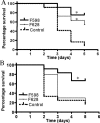Characterization of the opsonic and protective activity against Staphylococcus aureus of fully human monoclonal antibodies specific for the bacterial surface polysaccharide poly-N-acetylglucosamine
- PMID: 16622211
- PMCID: PMC1459728
- DOI: 10.1128/IAI.74.5.2742-2750.2006
Characterization of the opsonic and protective activity against Staphylococcus aureus of fully human monoclonal antibodies specific for the bacterial surface polysaccharide poly-N-acetylglucosamine
Abstract
Carbohydrate antigens are important targets of the immune system in clearing bacterial pathogens. Although the immune system almost exclusively uses antibodies in response to foreign carbohydrates, there is still much to learn about the role of different epitopes on the carbohydrate as targets of protective immunity. We examined the role of acetyl group-dependent and -independent epitopes on the staphylococcal surface of polysaccharide poly-N-acetylated glucosamine (PNAG) by use of human monoclonal antibodies (MAbs) specific for such epitopes. We utilized hybridoma technology to produce fully human immunoglobulin G2 (IgG2) MAbs from B cells of an individual post-Staphylococcus aureus infection and cloned the antibody variable regions to produce an IgG1 form of each original MAb. Specificity and functionality of the purified MAbs were tested in vitro using enzyme-linked immunosorbent assays, complement deposition, and opsonophagocytic assays. We found that a MAb (MAb F598) that bound the best to nonacetylated or backbone epitopes on PNAG had superior complement deposition and opsonophagocytic activity compared to two MAbs that bound optimally to PNAG that was expressed with a native level (>90%) of N-acetyl groups (MAbs F628 and F630). Protection of mice against lethality due to S. aureus strains Mn8 and Reynolds further showed that the backbone-specific MAb had optimal protective efficacy compared with the acetate-specific MAbs. These results provide evidence for the importance of epitope specificity in inducing the optimal protective antibody response to PNAG and indicate that MAbs to the deacetylated form of PNAG could be immunotherapeutic agents for preventing or treating staphylococcal infections.
Figures







Similar articles
-
The role of epitope specificity in the human opsonic antibody response to the staphylococcal surface polysaccharide poly N-acetyl glucosamine.J Infect Dis. 2005 Dec 1;192(11):2012-9. doi: 10.1086/497604. Epub 2005 Nov 1. J Infect Dis. 2005. PMID: 16267775
-
Molecular basis for preferential protective efficacy of antibodies directed to the poorly acetylated form of staphylococcal poly-N-acetyl-beta-(1-6)-glucosamine.Infect Immun. 2007 Jul;75(7):3406-13. doi: 10.1128/IAI.00078-07. Epub 2007 Apr 30. Infect Immun. 2007. PMID: 17470540 Free PMC article.
-
Structural basis for antibody targeting of the broadly expressed microbial polysaccharide poly-N-acetylglucosamine.J Biol Chem. 2018 Apr 6;293(14):5079-5089. doi: 10.1074/jbc.RA117.001170. Epub 2018 Feb 15. J Biol Chem. 2018. PMID: 29449370 Free PMC article.
-
Biologic properties and vaccine potential of the staphylococcal poly-N-acetyl glucosamine surface polysaccharide.Vaccine. 2004 Feb 17;22(7):872-9. doi: 10.1016/j.vaccine.2003.11.033. Vaccine. 2004. PMID: 15040940 Review.
-
The exceptionally broad-based potential of active and passive vaccination targeting the conserved microbial surface polysaccharide PNAG.Expert Rev Vaccines. 2016 Aug;15(8):1041-53. doi: 10.1586/14760584.2016.1159135. Epub 2016 Mar 16. Expert Rev Vaccines. 2016. PMID: 26918288 Free PMC article. Review.
Cited by
-
Opsonic and protective properties of antibodies raised to conjugate vaccines targeting six Staphylococcus aureus antigens.PLoS One. 2012;7(10):e46648. doi: 10.1371/journal.pone.0046648. Epub 2012 Oct 15. PLoS One. 2012. PMID: 23077517 Free PMC article.
-
Vaccination of yearling horses against poly-N-acetyl glucosamine fails to protect against infection with Streptococcus equi subspecies equi.PLoS One. 2020 Oct 15;15(10):e0240479. doi: 10.1371/journal.pone.0240479. eCollection 2020. PLoS One. 2020. PMID: 33057397 Free PMC article.
-
Invariant natural killer T cells: front line fighters in the war against pathogenic microbes.Immunogenetics. 2016 Aug;68(8):639-48. doi: 10.1007/s00251-016-0933-y. Epub 2016 Jul 1. Immunogenetics. 2016. PMID: 27368411 Free PMC article. Review.
-
Antibody to Poly-N-acetyl glucosamine provides protection against intracellular pathogens: Mechanism of action and validation in horse foals challenged with Rhodococcus equi.PLoS Pathog. 2018 Jul 19;14(7):e1007160. doi: 10.1371/journal.ppat.1007160. eCollection 2018 Jul. PLoS Pathog. 2018. PMID: 30024986 Free PMC article.
-
Antibody-mediated enhancement of community-acquired methicillin-resistant Staphylococcus aureus infection.Proc Natl Acad Sci U S A. 2010 Feb 2;107(5):2241-6. doi: 10.1073/pnas.0910344107. Epub 2010 Jan 19. Proc Natl Acad Sci U S A. 2010. PMID: 20133867 Free PMC article.
References
-
- Aase, A., and T. Michaelsen. 1994. Opsonophagocytic activity induced by chimeric antibodies of the four human IgG subclasses with or without help from complement. Scand. J. Immunol. 39:591-597. - PubMed
-
- Adem, P., C. Montgomery, A. Husain, T. Koogler, A. Arangelovich, M. Humilier, A. Boyle-Vavra, and R. Daum. 2005. Staphylococcus aureus sepsis and the Waterhouse-Friderichsen syndrome in children. N. Engl. J. Med. 353:1245-1251. - PubMed
-
- Blomster-Hautamaa, D. A., and P. M. Schlievert. 1988. Preparation of toxic shock syndrome toxin-1. Methods Enzymol. 165:37-43. - PubMed
-
- Boyce, J. 1997. Epidemiology and prevention of nosocomial infections, p. 309-329. In K. Crossley and G. Archer (ed.), The staphylococci in human disease. Churchill Livingston, New York, N.Y.
Publication types
MeSH terms
Substances
Associated data
- Actions
- Actions
- Actions
- Actions
- Actions
- Actions
Grants and funding
LinkOut - more resources
Full Text Sources
Other Literature Sources
Molecular Biology Databases

